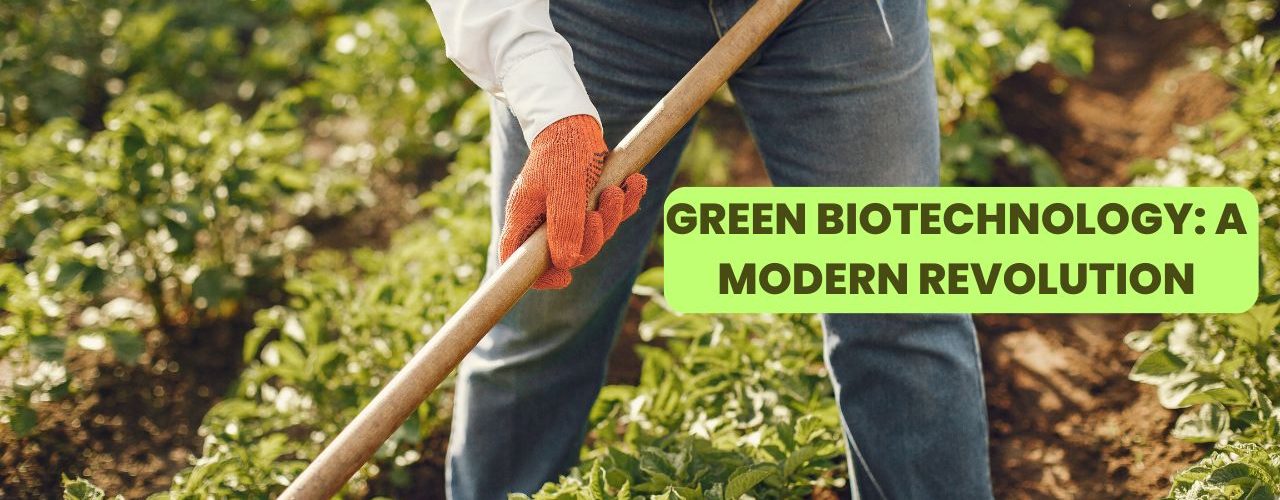Green Biotechnology: A Modern Revolution

Green biotechnology uses biotechnological instruments and methods to genetically modify crops and other creatures for the benefit of the world’s rapidly expanding population. The cultivation of crops with high yields, rich nutritional contents, resistance to insects, extended shelf life, and other desirable qualities, such as the ability to produce edible vaccines, produce monoclonal antibodies, perform phytoremediation, and more, are all potential benefits of green biotechnology.
Green biotechnology examples include genetic engineering, bioengineering, bioremediation, biofertilizers, biopesticides, genetically modified organisms (GMOs), and bioenergy. Optimized agronomic traits, nutritionally enhanced crops, insect, and microorganism (fungal, bacterial, and viral) resistant varieties, climate-smart plants, germplasm rescue and conservation, and bio-factories for the production and extraction of metabolites or pharmaceutical and industrial active chemicals are just a few examples of the products and processes that result from green biotechnology.
Green Biotechnology: The Scenario
Genetically Engineered (GE) crops have been grown by farmers since 1995. Biotech crops were planted by 7 million farmers in 18 countries in 2003, with over 85% of these farmers being low-resource farmers in developing nations. Approximately one-third of the global biotech cropland is grown in developing nations.
The topic of green biotechnology regularly receives a large amount of funding and research; however, the results have not been as good as anticipated. Whether or not to accept these Genetically Modified Organisms (GMOs) has long been shrouded in controversy. Granted that genetically modified agriculture is undoubtedly necessary, this technology is nonetheless considered to be the most enigmatic and divisive of our time. The red-green contrast in biotechnology has resulted from a long-term cultivation approach by the global media, despite the fact that the majority of countries accept it as a strategic tool for the new millennium.
The first food product created using biotechnology in 1990 was rice with moderate amounts of beta-carotene; since then, scientists have created “Golden Rice 2,” which yields significantly more. The potential of GM plants for phytoremediation, or the selective removal of contaminants, is also being investigated. To decontaminate the land and enable recycling or removal of the accumulated heavy metals, for instance, plants have already been genetically modified to grow on contaminated sites and accumulate heavy metal soil contaminants like mercury and selenium to higher levels. Worldwide consideration is currently being given to the use of molecular farming to produce genetically modified plant-derived medicinal proteins (PDPs). Human serum albumin, the first full-size native human recombinant PDP, was shown in 1990. An attempt is being made to generate the hepatitis B vaccine using potatoes and lettuce.
Importance and Advantages
Green biotechnology has numerous advantages for consumers, farmers, the environment, and society as a whole. Biotech crops provide the following benefits:
• Increase yields by 6%-30% on the same amount of land by producing sturdier varieties that are more vigorous, have softer shells, and have a longer shelf life.
• Genetically modified crops are resistant to insect and viral damage, thereby significantly reducing the need to spray crops.
• Reduction in fuel consumption and resultant CO2 production because of less tillage
• There are claims that their usage has already reduced the global environmental ‘footprint’ of production agriculture by 14%, including reductions of CO2 emissions in 2004, equivalent to taking 5 million cars off the road for one year.
• Production of better, more secure, and nourishing food and feedstuffs, like healthier vegetable oils; produce containing fewer harmful natural toxins, such as mycotoxins.
• Reduce the production cost of raw materials by increasing the economic viability of biofuel
• Allow farmers to grow more food more reliably in harsher climatic conditions.
• Reduce water usage to meet the Millennium Development Goal.
• Protect soils from erosion and compaction through less plowing.
Proponents of genetically modified organisms (GMOs) assert that the technologies employed are highly accurate and focused, and the resulting goods would be just as safe as natural products because gene transfer occurs naturally. These GM transformation techniques are independent, nevertheless. ZFNs (Zinc-finger Nucleases) were discovered by researchers to unintentionally trigger mutations in human cell lines. Unintentional mutations in numerous genomic areas were found to be caused by CRISPR (Clustered Regularly Interspaced Short Palindromic Repeats of Genetic Information) in a different study that used human cells. Efforts are underway to address these allegations by attempting to transfer genes—a process known as “cisgenesis” or “Intragenesis”—from an organism that is related to or already exists. For instance, one crop’s gene could be transferred to a different variety.
The same genetic techniques are used in cisgenesis as well; therefore, the outcomes could not be totally predictable because the new GM gene unit might contain genetic components from other creatures, such as bacteria or viruses, which could have unanticipated consequences. Studies show that cisgenic genetically modified organisms can alter plants in ways that are not predicted and present almost the same risk to human health and the environment as transgenic GMOs.
Negative Aspects
Numerous studies demonstrate the safety of genetically modified crops, yet it is discovered that these assertions are not entirely objective because the industry funds these studies. Few independent studies are conducted because they are unable to obtain the necessary funding or access genetically modified crops, which are shielded by a number of patent-based restrictions.
Despite these obstacles, very few studies have demonstrated the negative consequences of giving rodents genetically modified seeds. When the research findings from these experiments were published, the workers had to cope with intense defamation campaigns and the loss of their careers, demonstrating how closely GM firms and universities handle the debates and studies pertaining to genetically modified crops. Long-term ingestion of genetically modified crops is plainly harmful, as evidenced by the toxicities and negative consequences observed in feeding trials on lab and farm animals. Serious organ damage, a higher rate of large tumor formation, altered blood biochemistry, multiple organ damage and possible effects on male fertility, inexplicable death, a sustained immune response against genetically modified organisms and allergic reactions, troubled liver, pancreatic, and testicular function, liver aging, liver and kidney toxicity, intestinal abnormalities, and a host of other harmful effects have all been reported. There is no proof that eating commercially produced genetically modified food is safe in the long run. A small number of human investigations have revealed issues, but they were not investigated further.
The commercialization of any genetically modified crop should only occur following extensive research on human subjects to determine how the crops react. As of 2015, GMO product labels had to be present in 64 countries. Vermont became the first state in the US to require the labeling of goods containing genetically modified organisms (GMOs) in May 2014.
Future and Expectations of Green Biotechnology
For almost 15 years, foods made from genetically modified crops have been enjoyed by hundreds of millions of people worldwide with no known negative consequences. It is possible to halt the horizontal gene transfer between genetically modified and non-GM plants through physical isolation and genetic containment. The crop must be bred in isolation at every step of production in order to maintain physical isolation. On the other hand, genetic confinement refers to the development of incompatibility and sterility mechanisms to restrict the spread of pollen, such as Genetic Use Restriction Technologies (GURTS), which impede seed formation or fertility.
In 2001, a widely reported study revealed that Mexico, the global epicenter of this species’ biodiversity, had become polluted by GM genes from GM maize through cross-pollination. With every passing day, the technology used to create these genetically modified crops becomes more focused.
In addition to improving crop yield or shelf life and lowering the carbon footprint of the universe, genetically modified organisms (GMOs) also hold great promise for reducing the effects of disease (e.g., edible vaccines, pharmaceutical proteins, antibiotics), improving the nutritional value of food (Golden rice), and mitigating their effects. It looks highly promising to use genetically engineered food-grade organisms as recombinant vaccine expression hosts and delivery systems, opening up new directions in vaccination research. Numerous investigations have demonstrated that highly targeted gene transfer associated with genetically modified organisms is unlikely to result in unanticipated environmental impacts.
There are no GM crop varieties in use that pose a risk to consumers, according to extensive safety testing of GM crops and a rigorous risk assessment. GM cash crops are often processed so that no intact DNA or GM proteins are present in the final product. The development of this promising field will require strict labeling regulations, long-term, rigorous field experiments, and favorable public opinion in order to reap the benefits for the well-being of humanity while maintaining our environment.
Associations and Observations
The biotechnology companies BASF and Cibus have developed oilseeds from rapeseed and canola using a method that does not involve introducing foreign genes or gene expression control sequences. Instead, the targeted gene is altered by using the cell’s own gene repair system, known as the RTDS (Rapid Trait Development System), to specifically modify the gene sequence in situ.
Cibus presents their RTDS crops as naturally occurring, non-transgenic, and devoid of any foreign DNA insertion into the plants. To evaluate the fidelity and efficacy of the RTDS process and the extent to which unexpected alterations occur at other locations in the genome during the entire process, numerous in-depth studies such as whole genome sequencing of RTDS GMOs, analysis of targeted proteins produced by the RTDS-developed plants, and evaluation of functionality, utility, and safety will be necessary. This is because any new technology cannot be deemed safe enough to be used until it has been proven to be effective. RTDS has advantages and disadvantages of its own, despite being more focused than conventional recombinant technology.
In addition, listed below are a few green biotechnology businesses:
1. Monsanto
2. Syngenta
3. DuPont Pioneer
4. Novozymes
5. Amyris
6. Codexis
7. Intrexon
8. Synthace
9. Aemetis
10. Green Plains Inc.
11. Gevo
12. Evogene
The goal of green biotechnology is to create farming solutions that are more environmentally friendly than conventional agricultural and animal breeding practices. It covers a range of noncontroversial technologies for transforming food security, including tissue culture for large-scale production of nutritious planting material and molecular-assisted breeding for desired traits.
In summary, green biotechnology is a multidisciplinary discipline that has the ability to offer long-term answers to some of the most urgent environmental and agricultural problems facing the globe. Green biotechnology is anticipated to become more and more critical to creating a more sustainable and ecologically friendly future as technology develops and awareness of sustainability rises. To guarantee that these technologies have a beneficial impact on a world that is greener and more sustainable, it is imperative that the development and application of these technologies be approached with careful consideration of ethical, social, and environmental ramifications.
Top Click Blog Post







